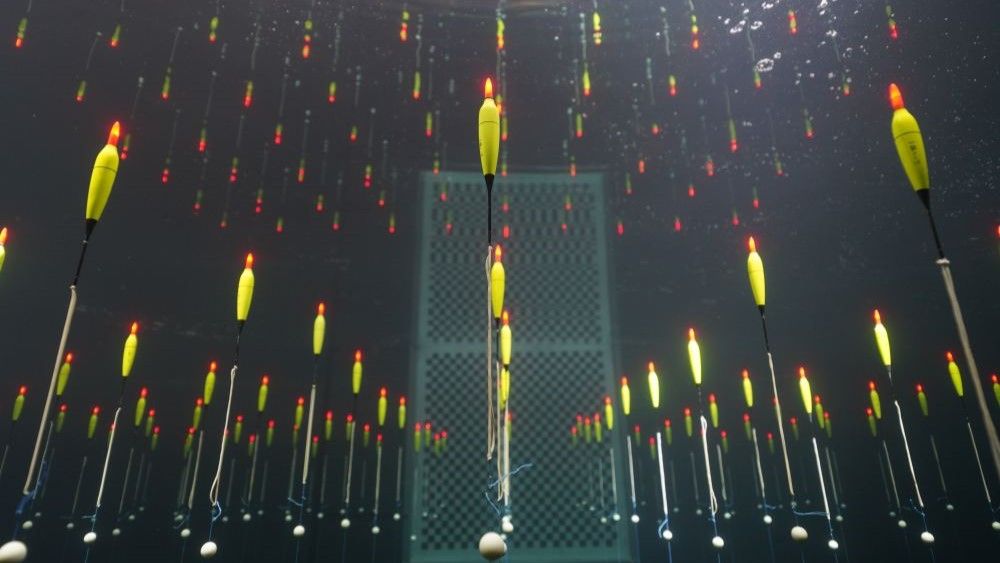China is building the world's largest underwater telescope to hunt for elusive 'ghost particles'
China's forthcoming Tropical Deep-sea Neutrino Telescope (TRIDENT) will search for the origins of cosmic rays in momentary flashes of light beneath the ocean's surface.

Scientists in China are building the world's largest "ghost particle" detector 11,500 feet (3,500 meters) beneath the surface of the ocean.
The Tropical Deep-sea Neutrino Telescope (TRIDENT) — called Hai ling or "Ocean Bell" in Chinese — will be anchored to the seabed of the Western Pacific Ocean. Upon completion in 2030, it will scan for rare flashes of light made by elusive particles as they briefly become tangible in the ocean depths.
Every second, about 100 billion ghost particles, called neutrinos, pass through each square centimeter of your body. And yet, true to their spooky nickname, neutrinos' nonexistent electrical charge and almost-zero mass mean they barely interact with other types of matter.
Related: 'Air showers' could help reveal cosmic rays' mysterious source
But by slowing neutrinos down, physicists can trace some of the particles' origins billions of light-years away to ancient, cataclysmic stellar explosions and galactic collisions.
That's where the ocean bell comes in.
"Using Earth as a shield, TRIDENT will detect neutrinos penetrating from the opposite side of the planet," Xu Donglian, the project's chief scientist, told journalists at a news conference Oct. 10. "As TRIDENT is near the equator, it can receive neutrinos coming from all directions with the rotation of the Earth, enabling all-sky observation without any blind spots."
Breaking space news, the latest updates on rocket launches, skywatching events and more!
Neutrinos are everywhere — they are second only to photons as the most abundant subatomic particles in the universe and are produced in the nuclear fire of stars, in enormous supernova explosions, in cosmic rays and radioactive decay, and in particle accelerators and nuclear reactors on Earth..
Despite their ubiquity, their minimal interactions with other matter make neutrinos incredibly difficult to detect. They were first discovered zipping out of a nuclear reactor in 1956, and many neutrino-detection experiments have spotted the steady bombardment of the particles sent to us from the sun; but this cascade masks rarer neutrinos produced when cosmic rays, whose sources remain mysterious, strike Earth's atmosphere.
Neutrinos pass completely unimpeded through most matter, including the entirety of our planet, but they do occasionally interact with water molecules. As neutrinos travel through water or ice, they sometimes create particle byproducts called muons that give off flashes of light. By studying the patterns these flashes make, scientists can reconstruct the energy, and sometimes the sources, of the neutrinos.
But to increase the chances of ghost particle interactions, detectors have to sit under a lot of water or ice.
China's gigantic new detector will consist of more than 24,000 optical sensors beaded across 1,211 strings, each 2,300 feet (700m) long, that will bob upward from their anchoring point on the seabed.
The detector will be arranged in a Penrose tiling pattern and will span a diameter of 2.5 miles (4 kilometers). When it's operational, it will scan for neutrinos across 1.7 cubic miles (7.5 cubic kilometers). The world's current largest neutrino detector, IceCube, located at the Amundsen-Scott South Pole Station in Antarctica, only has a monitoring area of 0.24 cubic miles (1 cubic km), meaning TRIDENT will be significantly more sensitive and much more likely to find neutrinos.
The scientists say that a pilot project will begin in 2026, and the full detector will come online in 2030.
"TRIDENT intends to push the limits of neutrino telescope performance, reaching a new frontier of sensitivity in all-sky searches for astrophysical neutrino sources," the researchers wrote in a paper outlining the detector, published Oct. 9 in the journal Nature Astronomy.

Ben Turner is a U.K. based staff writer at Live Science. He covers physics and astronomy, among other topics like weird animals and climate change. He graduated from University College London with a degree in particle physics before training as a journalist. When he's not writing, Ben enjoys reading literature, playing the guitar and embarrassing himself with chess.

